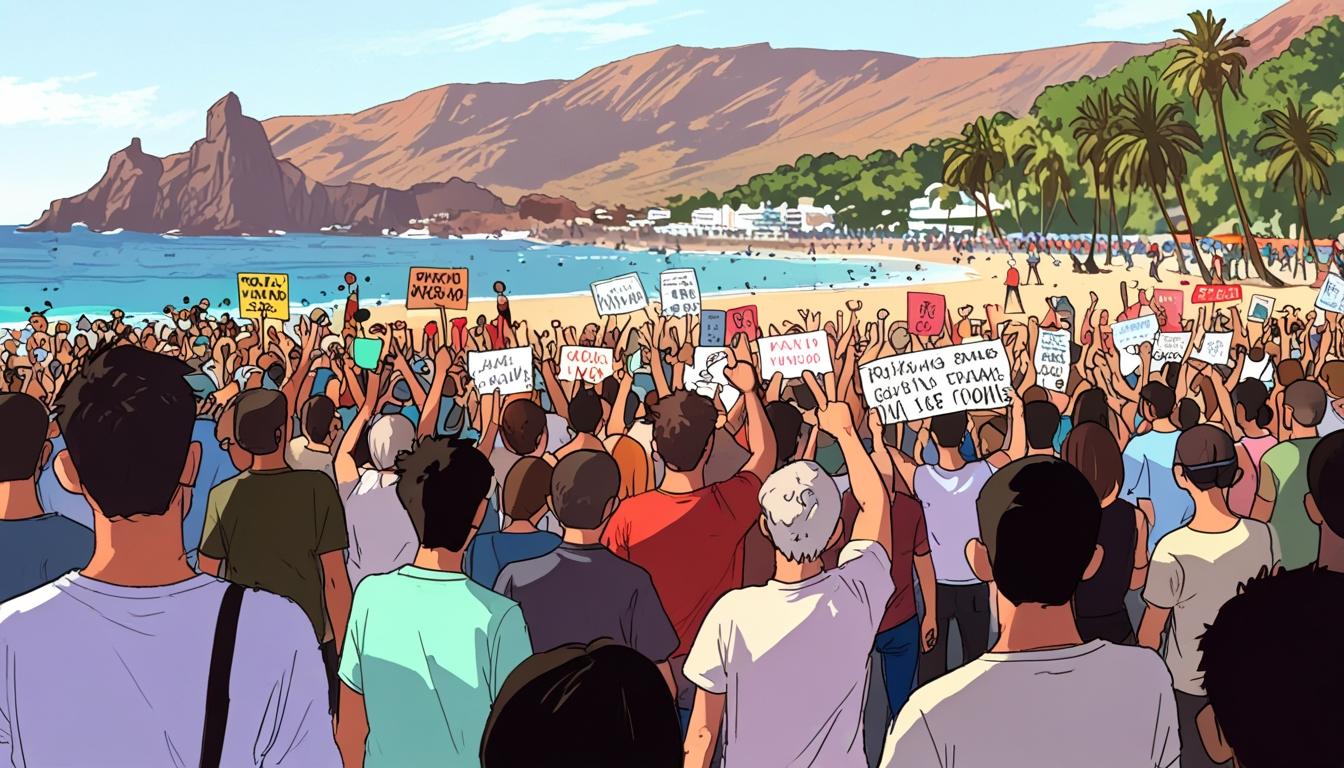The Canary Islands face a decline in hotel bookings following widespread local protests over the negative impacts of mass tourism. With residents demanding limits on visitor numbers and shifts towards sustainable practices, traditional travel patterns may be shifting in favour of alternative Mediterranean destinations like Turkey.
In recent months, the Canary Islands have become a focal point of growing discontent surrounding mass tourism. Reports indicate a significant drop in hotel bookings, raising alarms about the summer season ahead. Once regarded as a prime holiday destination for Brits, Tenerife—one of the most popular islands—faces a challenging landscape as locals express their frustrations over the impact of increasing tourist numbers on their quality of life.
Last year, an impressive 6.2 million international visitors graced Tenerife, drawn by its warm climate, beautiful beaches, and a vibrant hospitality industry. However, this influx has ignited resistance among residents who argue that the rising demand for holiday rentals is forcing them out of the local housing market. Demonstrators point to the strains of over-tourism, including traffic congestion and environmental degradation, which have further fuelled protests demanding that tourists “go home.”
Early indications suggest that anti-tourist sentiment is affecting travel choices. Despite an initial uptick in visitors earlier this year—with January seeing a 3.05 per cent increase—holidaymakers appear to have heeded the concerns voiced by locals. Numerous tourism operators have reported a marked decline in bookings as people reassess their travel plans against a backdrop of unrest.
Pedro Aldonso, president of the CEOE business association in Tenerife, has highlighted the fragility of traveller confidence. He stated, “Every small collapse has an echo in trust. When confidence falls, investment comes to a halt.” He emphasised the need for dialogue and mutual understanding to address the growing divide between locals and the tourism industry.
The protests are not an isolated phenomenon; they reflect a broader movement across Spain, where tens of thousands have rallied against what is perceived as unsustainable tourism practices. In April, reports indicated that 57,000 demonstrators in the Canary Islands called for limits on tourist numbers and measures such as an eco-tax to mitigate the environmental impact. Local residents have expressed concern that the current tourism model prioritises profit over their livelihoods and well-being, with many calling for urgent reforms.
While the tourism sector contributes approximately 35% to the economy of the Canary Islands and supports over 40% of local jobs, the model is increasingly viewed as unsustainable. In 2023, the islands welcomed around 16 million tourists, outnumbering the resident population of 2.2 million by more than seven times. This imbalance has heightened worries about resource depletion and the long-term viability of relying so heavily on tourism.
In response to the protests, TUI, a major European travel company, has recently decided to direct investments toward staff housing rather than expanding hotel accommodations. This shift reflects growing awareness among travel operators about the backlash against tourism and its associated issues. TUI’s CEO downplayed the extent of the protests reported in some media while underscoring the importance of addressing local concerns to maintain sustainable operations.
This mounting anti-tourism sentiment in the Canaries signals a potential shift in travel patterns within Europe. Nearby destinations, such as Turkey, are likely to benefit from the unrest, as tourists seek alternative locations that promise both relaxation and a more harmonious relationship with local communities. Turkish officials anticipate a record number of visitors this year, particularly from traditionally strong markets like Russia, Germany, and the UK.
As the Canary Islands grapple with these complex layers of discontent, the future of its tourism sector hangs in the balance. The situation calls for innovative solutions that address the needs of both tourists and local communities while ensuring the preservation of the islands’ unique environment and culture.
Reference Map
- Paragraphs 1, 2, 3, 4, 5, 6
- Paragraphs 1, 2, 6
- Paragraphs 2, 5, 6
- Paragraphs 4, 5, 6
- Paragraph 2, 6
- Paragraph 3
- Paragraph 3
Source: Noah Wire Services
- https://www.mirror.co.uk/travel/news/canary-island-tourism-chaos-hotel-35176937 – Please view link – unable to able to access data
- https://www.bbc.com/news/world-europe-68865755 – In April 2024, tens of thousands rallied across Spain’s Canary Islands against mass tourism, demanding limits on tourist numbers and curbs on uncontrolled development. Protesters, including residents and environmental groups, highlighted issues like unaffordable housing and environmental degradation. In 2023, the islands hosted 13.9 million tourists, about six times their population of 2.2 million. The tourism sector contributes 35% to the Canaries’ economy and 40% of jobs, but locals argue it’s unsustainable and harms their quality of life.
- https://www.france24.com/en/live-news/20240420-mass-protests-in-canary-islands-decry-overtourism – In April 2024, mass protests erupted across Spain’s Canary Islands, with an estimated 57,000 participants, against mass tourism. Demonstrators, including environmental groups, called for limiting tourist numbers, implementing an eco-tax, and halting property sales to non-residents. They argue that the current tourism model harms local residents and the environment. In 2023, the islands welcomed 16 million visitors, more than seven times their population of 2.2 million, leading to concerns over sustainability and resource depletion.
- https://www.reuters.com/world/europe/tui-offers-staff-housing-canary-islands-appease-anti-tourism-protests-2024-05-15/ – In May 2024, European travel giant TUI responded to anti-tourism protests in Spain’s Canary Islands by investing in staff housing instead of new hotels. Demonstrations in Tenerife and other islands called for reducing tourist numbers to alleviate pressure on the environment, infrastructure, and housing availability. TUI’s CEO emphasized proactive measures to address the issue, downplaying the extent of the protests reported in German media. Despite claims that package tourism doesn’t contribute to the housing crisis, TUI decided against investing in new hotels on the islands.
- https://www.ft.com/content/de15a5a3-941d-4da0-b928-3da70b6e31ac – Europe has seen intensified backlash against mass tourism, with protests in cities like Barcelona, Venice, and Amsterdam. In Barcelona, demonstrators used water pistols against tourists, highlighting local frustration over overcrowding, unaffordable housing, and environmental issues. Spain, the world’s second-most visited country, has experienced significant anti-tourism protests, particularly in the Canary Islands, Mallorca, and coastal cities. The tourism industry, vital to Spain’s economy, faces challenges in balancing local needs and economic benefits, prompting discussions on sustainable tourism practices.
- https://www.euronews.com/2024/04/21/thousands-protest-in-spains-canary-islands-over-mass-tourism – In April 2024, thousands protested in Spain’s Canary Islands against mass tourism, calling for limits on tourist arrivals and curbs on short-term holiday rentals. Demonstrators, supported by environmental groups, argued that the current tourism model has made life unaffordable and environmentally unsustainable for residents. In 2023, the islands welcomed 13.9 million visitors, about six times their population of 2.2 million. Protesters emphasized the need for a sustainable tourism model that considers environmental impacts and housing affordability.
- https://www.euronews.com/my-europe/2024/10/20/thousands-protest-against-over-tourism-in-canary-islands – In October 2024, around 30,000 people protested across Spain’s Canary Islands against over-tourism, demanding limits on tourist numbers and highlighting issues like unaffordable housing and environmental degradation. Protesters acknowledged tourism’s role in the economy but criticized low-skilled, poorly paid jobs and the negative impact on local communities. In 2023, over 16 million tourists visited the islands, more than seven times their population of 2.2 million, leading to overcrowding and resource depletion concerns.
Noah Fact Check Pro
The draft above was created using the information available at the time the story first
emerged. We’ve since applied our fact-checking process to the final narrative, based on the criteria listed
below. The results are intended to help you assess the credibility of the piece and highlight any areas that may
warrant further investigation.
Freshness check
Score:
8
Notes:
The narrative includes recent developments, such as the decline in hotel bookings and ongoing protests, indicating it is relatively current. However, specific events like the protests in April suggest it might be a compilation of recent news without extreme freshness.
Quotes check
Score:
8
Notes:
The quote from Pedro Aldonso could be original, as there are no easily accessible prior references online. However, without a direct confirmation of the quote’s origin, it remains uncertain.
Source reliability
Score:
7
Notes:
The Mirror is a well-known publication but can sometimes lean towards sensationalism. While generally reliable, it may not always adhere to the strictest journalistic standards as seen in outlets like the Financial Times or BBC.
Plausability check
Score:
9
Notes:
Tourism overload causing local discontent is a plausible issue, especially with the rising number of visitors compared to the local population. The shift in investments by companies like TUI reflects a plausible response to these concerns.
Overall assessment
Verdict (FAIL, OPEN, PASS): PASS
Confidence (LOW, MEDIUM, HIGH): HIGH
Summary:
The narrative is plausible and includes recent events, although its freshness is somewhat compromised by possibly being a compilation of previous news. The source reliability is good but not excellent due to potential sensationalism. Overall, the report seems accurate based on known issues with tourism in the Canary Islands.













